In the lives and work of two of the greatest poets in all of literature, Rosalis de Castro (February 23, 1837 – May 15, 1885) and Emily Dickinson (December 10, 1830 – July 15, 1885), there is a major similarity: the inclusion of nature.
Rosalía de Castro
Rosalia is known to have collected plants and press some of them. None of these sheets of the possible herbarium made by her have survived to today. But as demonstrated by a recent study 1, all of her work describes a very complete poetic herbarium of her Galician homeland. From roses and wheat to lilies, irises, violets, etc, and trees such as oak, chestnut and fig trees, etc. There are a total of 543 references to plants in her nine works, with roses standing out with 147 references. In fact, she herself said that she was “a rose with a sad smile, letting thorns fall.”
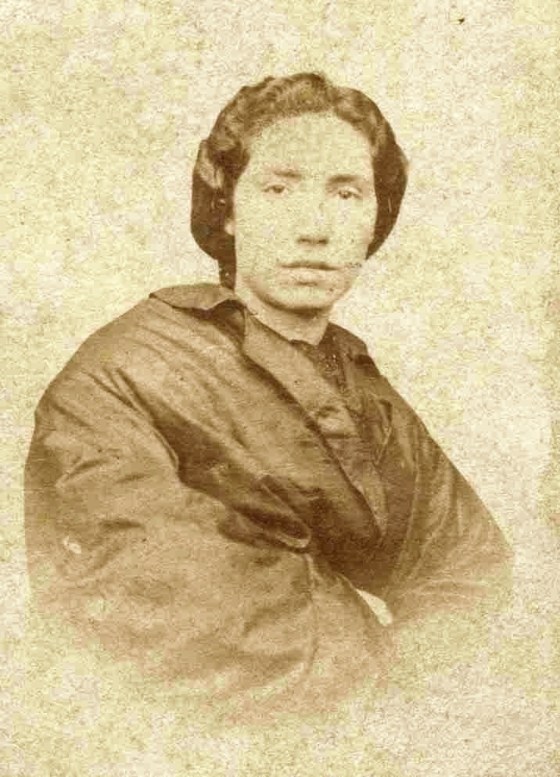
In the times in which we live, analysis of this ‘herbarium’ is of interest on a scientific level in several aspects. First, for giving value to wild-toxo plants, parietaria, henbanes – going beyond decorative or cultivated plants. And above all, for defending the trees in Galician landscapes, opposing their logging, and for the absence of certain plants that are now common in Galicia. For example, she does not mention camellias, which are now all over Galicia, and arrived after the death of the great poet. Despite this absence, the name Rosalia is now associated with a new variety of camellia – a hybrid of Portuguese origin. And there are also some famous trees – the Conxo oak in Santiago de Compostela, the second European tree of the year 2022, and a fig tree in the yard of her museum house in Padron – which are also associated with her, either for defending them, or possibly for having planted them (the fig tree).
In addition to the plants, in ‘Follas Novas’ especially, Rosalia also mentioned other elements from Galician nature like the rain, fog, springs, streams, the season… and many animals: goldfinches, sparrows, crickets, wolves, foxes, sheep, dogs, cats, etc. All of them used as symbols or for their suggestive power. For example, sparrows on the paths are a suggestion of the wild.
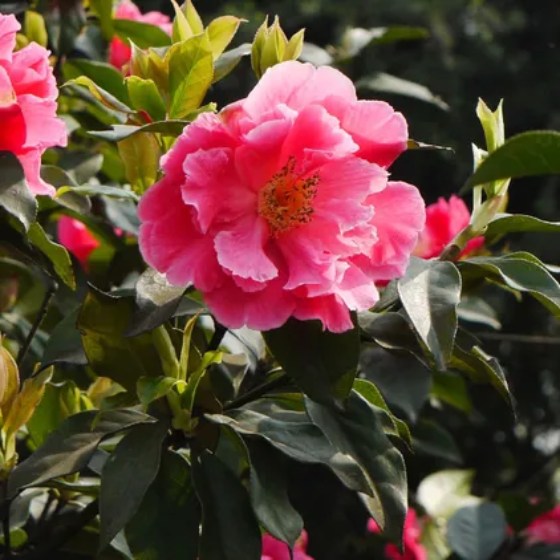
The name Rosalia has gone far beyond ‘our’ nature. It has reached the stars. A star was recently given her name and a planet that revolves around it was called ‘Sar River’, the river that appears in the title of one of her works. Both are located in the Ophiuchus constellation, 240 million light years from Earth. For the star, it has been recognized that she talks about a ‘red star’ that appeared when she was born in one of her poems. Could it be a very bright Mars?
Emily Dickinson
The presence of nature in the life and work of the great North American poet is even more extensive and deep. First, because in her youth at her school in Amherst, Massachusetts, she had a strong education in natural sciences, such as botany, zoology, geology, astronomy, etc. And then, following a short stay at a seminary, when she secluded herself in her childhood home, she stayed in contact with the scientific advances in these fields by reading newspapers and books. All of this is reflected in the fact that plants, animals, stars, volcanoes, etc. appear throughout the nearly 1,800 poems and hundreds of letters that were published after her death.
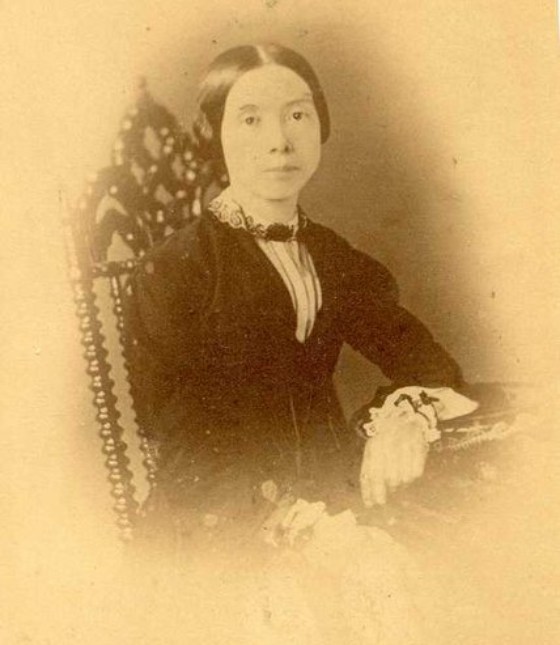
The first indication we have of her great interest in plants is the herbarium she made when she was 14 years old, and which still survives today at Harvard University, where it was digitalized and made accessible online.2 She included over 400 plants in it – some cultivated in a garden where she took care of them and others from nature in the area where she was born and lived. Although it cannot be used in its entirety from a scientific standpoint as some sheets are missing parts in order to be fully analyzed, or the place where she collected them is missing, it is still remarkable that most are identified with their Linnaean scientific names, which points to her strong education as a naturalist. It has also served to illustrate how some plants she included have changed over time. And even to demonstrate how others have disappeared from the vegetation in the area.
Continuing with the plants, Emily really liked roses like Rosalia, but as she herself recognized, their existence can be associated to another plant. It is the so-called ‘Indian pipe plant’, which is pure white, hard to see, ghostly in appearance and grows in dark places, apparently – it was believed at the time – taking advantage of decomposing organic matter. And there grows, as she says, “my favorite plant of my life” which grows from what has died. In her reclusion, Emily also dressed in pristine white and hardly allowed herself to be seen, with a ghostly appearance.
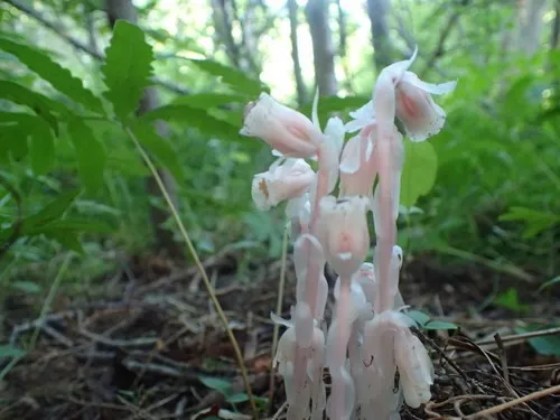
Research on this plant, Monotropa uniflora, has demonstrated that it does not “feed” off of organic waste (in biology if that were the case it would be called saprophytic). Instead, it is a parasite of the fungus on the ground – the mycorrhizae – that live in symbiosis with the roots of the plants. It was recently determined that the loss of color is due to the fact that the chromosomes from their chloroplasts have lost the genetic information to synthesize the green pigments that carry out the chlorophyll function (3), something that they no longer need as they obtain their ‘food’ from the mycorrhizae.
And moving directly to her poems, the animals and plants she mentions in many of them are symbolic, without going into details. But there are some poems, like the one where she tries to describe a hummingbird, in which the characteristics stand out in a very poetic manner: “A Route of Evanescence / with a revolving Wheel – / A Resonance of Emerald / A Rush of Cochineal – / And every Blossom on the Bush / Adjusts it’s tumbled Head – / The Mail from Tunis – probably, / An easy Morning’s Ride –.” Great. And regarding the problem of the species of the organisms she mentions, in general, she does so in a very ‘scientific’ manner like in her herbarium. But she sometimes has a common / regionalist bias; in other words simple and unrefined, as she says, ‘New Englandly’, from New England, her region. On the other hand, in some of her poems she is ahead of recent scientific discoveries like the one that detected that communication exists among plants by emitting sounds. For example, in her ¡poem 1098 – she did not give titles to her poems that she wrote on loose pieces of paper and when they were published, they were numbered -she describes this as “The leaves, like women, interchange / Sagacious confidence.”
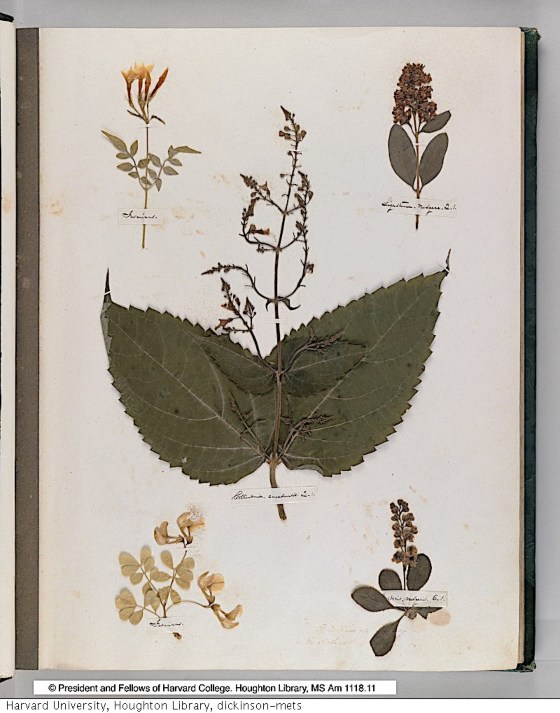
Emily also used her scientific knowledge to try to maintain a position at least as an eclectic between religion and science. It is well known that during her time at school, and especially in seminary, she refused to join the wave of fundamentalism that was spreading across the U.S at the time. Therefore, when Darwin published his Origin of the Species (1859) and The Descent of Man (1872) years later and she read them directly or in reviews in the newspapers, our poet saw her position reinforced. Even in an environment in which her family and friends were completely keen on creationism and against evolutionism. In fact, in at least three letters from these years she mentions Darwin specifically as “the mind that has stolen religious idea” and that Darwin “had thrown the Redeemer away.” And in the end, she has two very defining poems about this problem, for example: “Faith” is a fine invention / For Gentlemen who see! / But Microscopes are prudent / In an Emergency!”; and “Some keep the Sabbath going to Church / I keep it, staying at Home / With a Bobolink for a Chorister / And an Orchard, for a Dome.”
Finally, we would like to note that in some poems, she introduced other elements from nature like volcanoes (for example the Teide and the Chimborazo, both visited by Humboldt, who she must have read either directly or indirectly) and ‘stars’ (the moon and the Perseids, for example). And here once again, like Rosalia, astronomy has recognized Emily Dickinson, giving her name to a crater on Venus.
Manuel Ruiz Rejón
Notes
- López-Sández M, Fraga Vila, M.I., Fraga Vila, M (photography). 2022. Rosalia’s herbarium. Fundación Rosalía de Castro.
- Emily Dickinson Herbarium. In Harvard Library Viewer.
- Ravin, N.V. 2016. The loss of photosynthetic pathways in the plastid and nuclear geomes of ….Monotropa…16 (Suppl 2):238. BMC Plant Biology
Comments on this publication